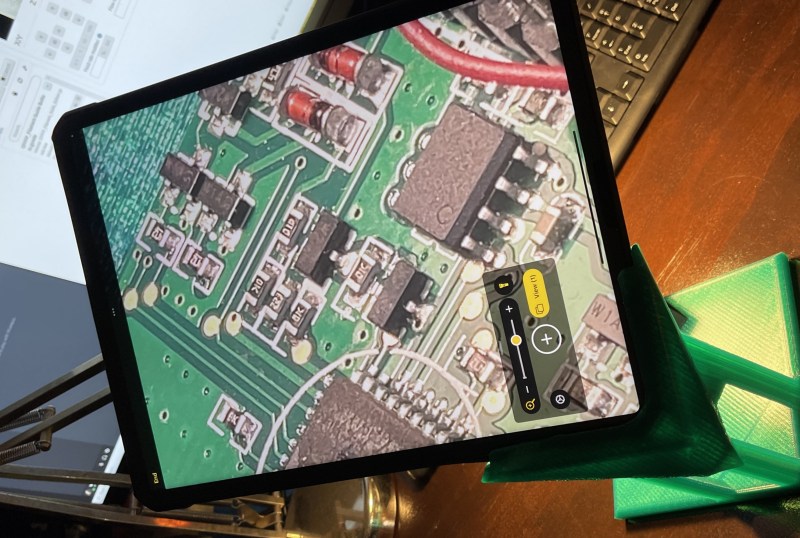Be it the ever shrinking size of components, the miniscule size of the printing on such pieces, or the steady march of time that makes visits to the optometrist an annual ritual, many of us could use some assistance when things start getting fuzzy at the workbench. Arm-mounted LED magnifying lenses can be a handy helper. Zooming in on a macro photo on a smartphone is also a common option that we’ve used many times.
[Timo Birnschein] started down a similar path when he realized that his iPad Pro comes with an app called simply “Magnifier”. A 12” iPad isn’t exactly the most convenient device to hold while trying to solder small parts, so he spent some time designing and 3D printing a specialty iPad stand that he calls a “Quick and Dirty High Performance EE Microscope.” We call it a magnificent tool hack!
Rotating the iPad diagonally so that the camera is closest to the subject leaves plenty of room to work and makes great use of the available screen space. [Timo] reports that at 50% magnification the 12” screen makes even 0603 SMD parts easy to read. Now he rejoices to have more to do with his iPad than watching YouTube and reading Hackaday- although we don’t know why you couldn’t do both.
The STL files have been released on Thingverse for your experimentation. [Timo] notes that he’d like to add an LED ring to brighten things up, and a fume extractor to protect the delicate lens on the iPad. We have to wonder if some plastic wrap over the lens might produce the same effect at almost no cost. Whatever [Timo] decides to do, we’re sure it’ll be brilliant.
If you don’t have an iPad and a 3D printer, you might enjoy an earlier post that shows how you can use your phone as a microscope. If Lego and Raspberry Pi are your go-to parts, you can set your sights on this Lego/Pi/Arduino microscope.
Do you have your own preferred solution for seeing yourself through a hazy situation? Be sure to write it up, and then drop it in the Tip Line!
















Good idea! I wonder if I can use the built in camera app on my ancient iPad mini, might breathe some new life into it.
Very cool! Thanks. Note to iPad owners: You have to enable Magnifier under Accessibility in Settings.
What is the latency like? I don’t own any Apple products so I have no idea what the magnifier is like. I’ve played with a few cheap USB microscopes on PC years ago that offered good magnification for doing small pitch soldering and inspection, but the latency made it unusable. Is this better?
I just tried it. It is “live” as far as I can tell.
I mean its just the native camera using its own zoom so I’d imagine the latency is extremely low.
I have noticed no lag, at least not in a way that would have annoyed me in any sense of the word. It feels very snappy and responsive to me.
I did try soldering, though, and it becomes very apparent why expensive microscopes offer stereo vision. It is extremely difficult to estimate depth when almost everything is in focus and gigantic. Getting to the solder joint with the soldering iron is already finicky but then also adding solder is downright difficult.
I guess one can get used to it but it’s certainly not immediately natural :)
I live it for inspection tasks!
Thanks for the responses. I might give something similar a try using my Samsung Galaxy. My eye sight isn’t what it used to be.
I used to do the same with my old phone and one of those clip-on lenses. I put the macro one and it was wonderful. But I had to replace it and now it has 2 cameras and I can’t put the lenses on them at once. I might sound like an elder shouting to a cloud but I think those multicameras ruined it for the improvised soldering microscope.
You can get a clip on Lens on eBay for a few bucks or scavenge one from an old cd dvd or Blu ray (not the objective lens in the front, but the clear plastic collimating lens after the beams litter(s). On a Blu ray it will be mounted to a tiny stepper motor). Optical magnification is always a good place to start to make digital work properly.